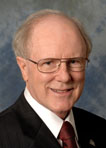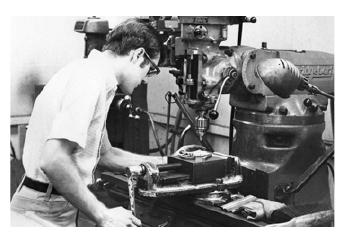
One day soon, in a theater near you, the movie you see on the screen won't originate in a reel of film threading through a projector. It won't be the product of light passing through a series of celluloid frames. Instead, you will see a digital image, composed of light reflected by millions of microscopic mirrors. This image will always have the pristine quality of opening night—unscratched, unfaded. Exhibited with a technology that imparts no extraneous motion, it will not jump or flutter. And thanks in part to the combined operations of those flashing mirrors, it will boast a palette of no fewer than 35 trillion colors.
Larry J. Hornbeck, who earned a Ph.D. in solid state physics from Case Western Reserve University in 1974, invented the optical semiconductor at the heart of this new cinematic world. Yet he didn't have movies in mind when he began applying the principles of reflection to the manipulation of light. Back in 1987, when Hornbeck built the first Digital Micromirror Device (DMD), his goal was to develop a high-tech airline ticket printer. Since then, however, he has led a revolution extending from office projectors to high-definition TVs to digital cinema.
DLP® projection technology, based on his DMD, has captured a worldwide market share of nearly 50 percent. In the process, Hornbeck has accumulated 33 patents and a host of professional honors. Most recently, he was awarded the 2007/2008 Prize for Industrial Applications of Physics from the American Institute of Physics and elected to membership in the National Academy of Engineering. In 1998, Hornbeck received an Emmy Award in engineering, and though he hasn't yet won an Oscar, every Academy Awards ceremony since 1997 has been projected with DLP® technology.
Curious About Everything
In a sense, Hornbeck's involvement in the entertainment industry extends back more than 50 years. Born in 1943, he grew up in Portland, Oregon, where he first showed promise not as a scientist, but as a musician. He played the Hammond organ as a boy, performing on a local radio station and competing for a spot on Ted Mack's Original Amateur Hour. His inspiration was his father, who had no musical training but who bought the organ and started "practicing and playing by ear." When the young Hornbeck expressed an interest, the family arranged lessons for him.
"My father had a wonderful outlook on life," Hornbeck says. "He only had an eighth-grade education, but he was just curious about everything in the world. And he had all kinds of hobbies." In 1957, after the family moved to Indiana, a new hobby took hold: "Out of the blue, my father started buying transistors and books on how to wire up things. At that time, transistors had only been out for a few years— Texas Instruments, Sylvania, Raytheon." Soon, Hornbeck was earning merit badges in radio and electronics and had his own radio repair business.
After a few more family moves and a flirtation with astronomy, Hornbeck graduated from high school in Parma, Ohio, and enrolled at Case Institute of Technology, where he completed a bachelor's degree in physics in 1965. It didn't seem likely that he would remain here for graduate school; other universities made offers, and he was selected for a traineeship with the National Science Foundation (NSF). But when he told William Gordon, one of his Case physics professors, about the NSF opportunity, Gordon said, "I think we can match that." Later, Gordon became his thesis advisor.

Hornbeck's doctoral research had a strong experimental component. To carry it out, he modified a furnace to produce single-crystal metal alloys and created all sorts of hand-built, specialized electronics, as well as mechanical widgets that had to work at one degree above absolute zero. In fact, Hornbeck spent so much time in the staff machine shop that they made him the foreman. ("It was a puff job," he says. "I kept the tools in working condition and the shop stocked with material.")
This wasn't exactly the standard path to a Ph.D. in physics, but his advisor didn't object. "I cannot tell you how much Bill Gordon meant to me—though I may not have appreciated it at the time," Hornbeck says. "He gave me the independence that I needed to do what I needed to do, to pull a lot of different things together. And had I had someone who said, 'Now look, you're here for the physics, so toe the line,' I would not have had the opportunity to learn so many other things that were actually going to enable me to find my first job. I was just very, very lucky. He's a real gentleman."
Hornbeck found that first job at Texas Instruments, where he has spent his entire career. Impressed by his broad experience, the firm's research director hired him even though Hornbeck knew nothing about the device or the materials he was initially asked to work on. "I learned silicon processing, modeling, and manufacturing," Hornbeck recalls. "Texas Instruments was my postgraduate school. And it was the sort of opportunity that my dad would have taken advantage of in a nanosecond—although he wouldn't have used that terminology."
"One of the Lumière Guys"
Before the advent of digital cinema, made possible by Hornbeck's DMD and DLP® Cinema technology, the basic projection mechanism for film had changed little since 1895. That was the year when the Lumière brothers first exhibited a program of short movies for a paying audience in the basement of a Paris café. That event is generally regarded as the "birth of cinema."
Even as other entertainment media went digital toward the end of the 20th century, the motion picture industry continued to rely on film-based exhibition. In the late 1990s, however, director George Lucas began calling for a new, all-digital approach. By then, Hornbeck had elaborated the DMD chip so that it contained, not the hundreds of micromirrors he had mounted on his first prototype, but more than one million mirrors—enough to project a high-quality image onto a 75-foot screen.
DLP® Cinema premiered in 1999, in New York and Los Angeles, with showings of Lucas's Star Wars: Episode 1—The Phantom Menace. In L.A., the day before the public premiere, Hornbeck attended what promoters called a "shootout," with digital and conventional versions of the film shown side by side in a split-screen format. He chose a seat in the third or fourth row, away from everyone else, and as he watched clips from the movie, his imagination carried him back a century. You might even say he engaged in a form of projection:
I'm one of the Lumière guys, he remembers thinking. I'm down in the basement of the café, and I'm watching the audience, and I understand the significance. I understand that this hasn't been done before, and what a feeling they must have had from that.
"I'd never thought about it before," Hornbeck says, "but I suddenly realized that the shootout was a historic moment. To me, it was the equivalent of the Lumière brothers' film exhibition a century earlier. It was the birth of digital cinema."
Since then, the conversion to the new technology has proceeded apace. Last year alone, the number of American theaters with DLP® Cinema doubled, from 2,500 to 5,000, and there are plans to install the technology in all 30,000 of the nation's movie houses. The potential global market consists of more than 100,000 theaters.
"It's interesting," Hornbeck says, "that for over 100 years, the movie industry evolved along a separate path from radio and television and only now is undergoing a complete digital transformation, from image capture to post-production and exhibition. I am proud that I could make a lasting impact on the industry."
